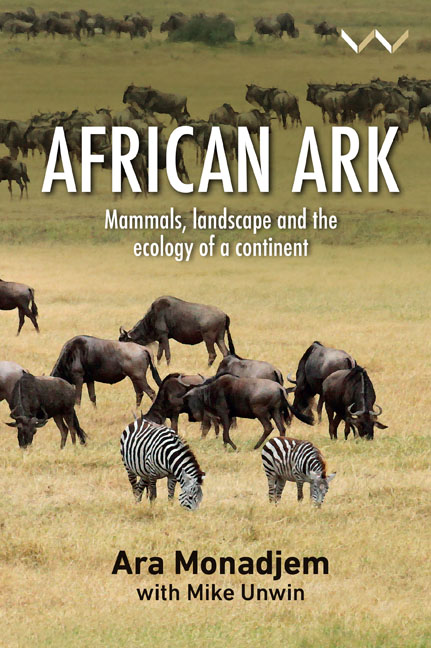Book contents
- Frontmatter
- Dedication
- Contents
- List of Plate Photographs
- List of Figures and Tables
- Acknowledgements
- Foreword
- Preface
- Chapter 1 A Continent of Plenty
- Chapter 2 The Species Conundrum
- Chapter 3 The History of Africa’s Mammals
- Chapter 4 Islands as Species Factories
- Chapter 5 Evolution on the African Mainland
- Chapter 6 Giant Mammals Shaping the Landscape
- Chapter 7 A Place for Every Species
- Chapter 8 Fluctuating Populations
- Chapter 9 The Human Factor
- Chapter 10 The Sinking Ark?
- Glossary
- Notes
- References
- Recommended Reading
- Index
Chapter 4 - Islands as Species Factories
Published online by Cambridge University Press: 29 November 2023
- Frontmatter
- Dedication
- Contents
- List of Plate Photographs
- List of Figures and Tables
- Acknowledgements
- Foreword
- Preface
- Chapter 1 A Continent of Plenty
- Chapter 2 The Species Conundrum
- Chapter 3 The History of Africa’s Mammals
- Chapter 4 Islands as Species Factories
- Chapter 5 Evolution on the African Mainland
- Chapter 6 Giant Mammals Shaping the Landscape
- Chapter 7 A Place for Every Species
- Chapter 8 Fluctuating Populations
- Chapter 9 The Human Factor
- Chapter 10 The Sinking Ark?
- Glossary
- Notes
- References
- Recommended Reading
- Index
Summary
We often view islands as beautiful retreats where a city-weary humanity can forget about the pressures of day-to-day life. However, islands are also valuable destinations for ecologists and evolutionists. Historically, indeed, they have been pivotal to our understanding of evolution: it was the natural history of the Galápagos Islands, after all, that inspired Charles Darwin's theory of evolution by natural selection – and Darwin himself was heavily influenced by the work of Alfred Russel Wallace, who had already arrived at similar conclusions in the Malay Archipelago.
The advantage of islands for the evolutionist is that their ecosystems are relatively simple, so otherwise complex ecological interactions are much easier to study than in their mainland equivalents. This makes perfect sense when one recognises that for any terrestrial organism to inhabit an oceanic island, its ancestors must have travelled across open water to get there. Such a challenge immediately limits the number and kinds of organisms that are likely to make and survive the journey. Birds and bats are both well represented on islands, their powers of flight enabling them easily to cross over from the nearest mainland. Frogs, typically, are not: not only do they lack wings, but also their permeable skin does not tolerate immersion in salt water for even short periods. By this measure, rodents and terrestrial reptiles are intermediate in their ability to colonise islands – doing so by rafting across the sea on floating debris (as discussed in chapter 3). Although such a journey may appear implausible – and in fact, it is implausible! – we need to remember that 100 000 years in evolutionary terms is the mere blink of an eyelid. Over such prodigious amounts of time, even the most improbable event is likely to happen – even if only once. In the words of celebrated US palaeontologist George Gaylord Simpson, ‘any event that is not absolutely impossible … becomes probable if enough time elapses’ (cited in Krause 2010: 613–614).
Islands have two fundamental features that ultimately determine the number of species that inhabit them: their size and their distance from the mainland. Larger islands are more likely to be accidentally colonised, because the chances of running ashore on a larger landmass are greater than those of doing so on a smaller one.
- Type
- Chapter
- Information
- African ArkMammals, Landscape and the Ecology of a Continent, pp. 79 - 98Publisher: Wits University PressPrint publication year: 2023



